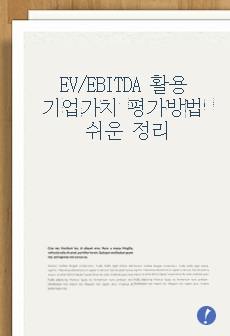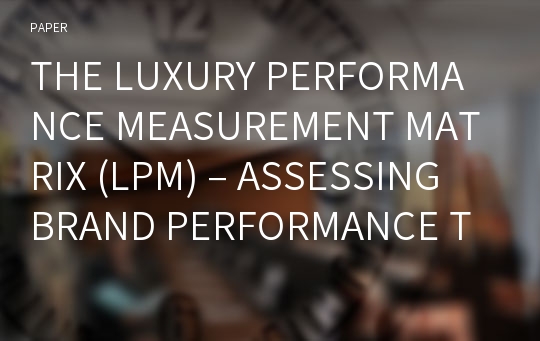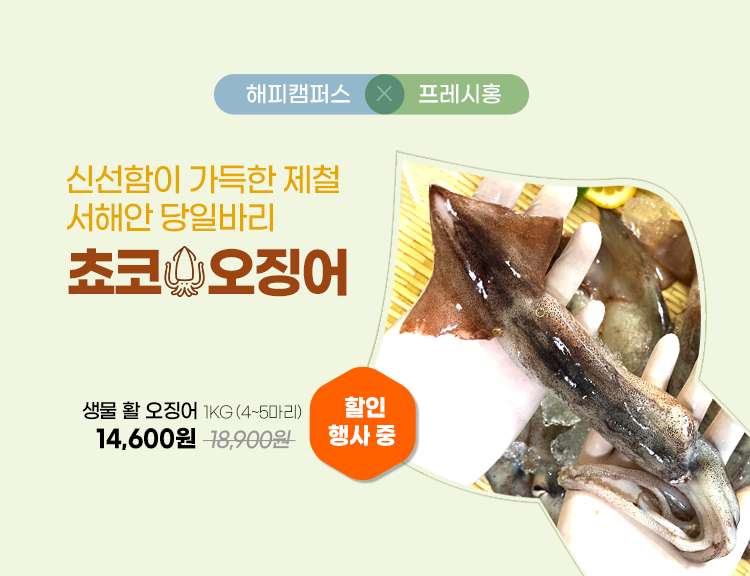THE LUXURY PERFORMANCE MEASUREMENT MATRIX (LPM) – ASSESSING BRAND PERFORMANCE THROUGH A VALUE CREATION APPROACH
* 본 문서는 배포용으로 복사 및 편집이 불가합니다.
서지정보
ㆍ발행기관 : 글로벌지식마케팅경영학회(GFMC)
ㆍ수록지정보 : GFMC Session1
ㆍ저자명 : Ana Roncha, Matteo Montecchi
ㆍ저자명 : Ana Roncha, Matteo Montecchi
영어 초록
INTRODUCTIONThe term luxury usually defines not a category of products but a conceptual and symbolic set of dimensions. These dimensions comprise values that are strongly related to cultural elements and the wider socio-economic context (Vickers & Renand, 2003). Vickers and Renand (2003) recognised luxury goods as symbols of personal and social identity. Luxury is often used as a social marker, as a social stratification tool to reinforce a hierarchy (Okonkwo, 2010, Kapferer & Bastien, 2009).
Due to the subjective nature of the luxury concepts and the complexity to define it, perceptions of luxury brands are not consistent across market segments and geographic locations (Phau & Prendergast, 2000), since they depend largely on each consumer's perception of indulgence. A common denominator between consumers in both Western and Eastern cultures is that the purchase of luxury brands serves to portray individuality and/or social standing (Nueno & Quelch, 1998; Vigneron & Johnson, 2004). Consumption of luxury brands is largely determined by social function attitudes (i.e. self-expression attitude and self-presentation attitude) as consumers express their individuality (e.g., need for uniqueness) and exhibits their social standing (e.g., self monitoring) through luxury brands (Wilcox et al., 2009).
It is of growing importance for researchers and managers to understand how consumers' perceptions of value, influences buying criteria and behaviour (Tynan et al., 2010; Wiedmann, Hennigs, & Siebels, 2007).
The perception of value by consumers is given a higher importance (Tynan et al., 2010) however the measurement of luxury value is not agreed amongst scholars and practitioners.
Vigneron and Johnson (2004) proposed a structure of the luxury concept and presented the “brand luxury index” framework. Wiedmann et al. (2007) offered a conceptual model of luxury value perceptions highlighting four dimensions, namely: social, personal, functional, and financial values.
Tynan et al. (2010) have adapted the earlier work by Smith and Colgate (2007) on generic value framework and suggested a conceptual model based on the following concepts: utilitarian, symbolic/ expressive, experiential/hedonic, relational, and cost/ sacrifice value.
With the emergence of new concepts and levels of luxury, the measurement of value becomes even harder. According to Unity Marketing (2006) “…‘old luxury’ was about the attributes, qualities and features of the product and much of its appeal was derived from status and prestige. The new luxury consumer defines the category from their point of view. Today’s new luxury consumers focus on the experience of luxury embodied in the goods and services they buy, not in the ownership itself.”
Robins and Ricca (2012) propose an alternative perspective on the established ‘new’ vs. ‘old’ luxury dichotomy. According to the authors, the more brands define themselves as belonging to the world of luxury, the more the concept becomes meaningless as luxury becomes ‘massified’. They introduce the concept of Meta-Luxury as a new form of luxury that escapes the cliché of luxury and establishes the “luxury beyond luxury”.
In these complex scenarios, luxury brands are on a constant quest to remain relevant and maintain a sustainable competitive advantage.
According to Beverland (2004) marketers now need to use “a complex combination of dedication to product quality, a strong set of values, tacit understanding of marketing, a focus on detail, and strategic emergence” in order to effectively manage luxury brands.
With the recent focus on co-creation of value, luxury brand management has evolved to include dialogue and complex interactions between the brand owner, employee, customers and other social groups and communities (Tynan et al. 2010) making success factors harder to track.
Purpose
This paper aims to conceptualize a measurement tool that could be used in the evaluation and classification of a luxury brand’s performance and to assess how these dimensions evolve as the brand moves from mature towards more emerging luxury markets.
This paper seeks to make a contribution, by providing a systematic review of the definitions of a luxury brand provided by various authors. It seeks to establish patterns and inconsistencies and to summarise them in a performance measurement matrix (the LPM framework) which can be used to identify growth strategies and to support future managerial developments.
Design/methodology/approach
The methodological approach followed in this paper was to systematically review the academic literature on luxury brands and to reduce the numerous factors cited as components and identifiers of luxury brands to a more manageable number of macro-themes. Through the analysis of the dimensions identified (with a further distinction between ‘new’ and ‘old’ luxury brands), the researchers intended to clarify the key elements of success that impact on brands competitiveness, leading to the definition of the items in the scale.
In order to validate the elements, a survey was implemented to identify the most crucial indicators by building on the results of the systematic review. The aim of the survey was to clarify detailed criteria for each of the dimensions in order to construct an effective measurement scale.
The scale was tested on four luxury brands selected amongst those perceived as ‘old’ / traditional luxury and ‘new’/emergent luxury.
Findings
Amongst academics and practitioners there is no common agreement or clear parameters that delineate what luxury is or the strategies such brands employ. This leads to confusion in the definition of the elements that constitute a luxury brand as well as in the brand management process.
This paper proposes an alternative measurement scale to the Brand Luxury Index Scale developed by Vigneron and Johnson by focusing on a strategic overview of the performance of luxury brands in the UK market. It attempts to evaluate the performances of key luxury players by using a value-curve approach (Kim and Mauborgne, 2005) as a measurement tool. The value curve is a both a diagnostic and an action tool which captures the current state of play in the market space.
The different constituents of the proposed Luxury Performance Matrix (LPM) should be considered when measuring the performance of a luxury brand and its capacity for value creation.
The visual representation of the LPM model, allows marketers and brand managers to easily evaluate what aspects and strategic directions should be prioritized. It also allows to capture the brand’s performance across the key competitive factors of the industry and to determine which factors need to be raised above competition as way to increase competitiveness in the marketplace.
The Luxury Performance Matrix proposed in this paper represents a major contribution to the measurement and evaluation of the competitive performances of established and ‘new’ luxury brands, in mature and emerging markets.
Originality/value
The proposed matrix will allow luxury brand managers to assess the current presence in the marketplace and develop more in-depth understanding of the brand’s performance. The findings provide valuable strategic insights for luxury brands operating across emerging and established product/market contexts.
참고 자료
없음"GFMC Session1"의 다른 논문
 FAST AND SLOW FASHION BRANDS IN DEVELOPING SUSTAINABLE ..6페이지
FAST AND SLOW FASHION BRANDS IN DEVELOPING SUSTAINABLE ..6페이지 “WHAT IF A CELEBRITY AND A BRAND CO-CREATE A NEW COLLEC..7페이지
“WHAT IF A CELEBRITY AND A BRAND CO-CREATE A NEW COLLEC..7페이지 THE INSTAGRAM’S STRATEGY IN ENGAGING THE CUSTOMER’S LOY..3페이지
THE INSTAGRAM’S STRATEGY IN ENGAGING THE CUSTOMER’S LOY..3페이지 THE PARTICULARITIES OF NEW PRODUCT DEVELOPMENT IN THE T..5페이지
THE PARTICULARITIES OF NEW PRODUCT DEVELOPMENT IN THE T..5페이지 THE LONE CHOCOLATE BAR: THE INFLUENCE OF PERCEIVED SCAR..6페이지
THE LONE CHOCOLATE BAR: THE INFLUENCE OF PERCEIVED SCAR..6페이지 ADS AS WORKS OF ART: MEASURING ADVERTISING IMMERSION3페이지
ADS AS WORKS OF ART: MEASURING ADVERTISING IMMERSION3페이지 ECONOMIES OF SMALL: NICHE STRATEGIES AND SUCCESS FACTOR..8페이지
ECONOMIES OF SMALL: NICHE STRATEGIES AND SUCCESS FACTOR..8페이지 THE INFLUENCE OF ONLINE CUSTOMER REVIEWS ON RETAILERS' ..6페이지
THE INFLUENCE OF ONLINE CUSTOMER REVIEWS ON RETAILERS' ..6페이지 IS THE ARTIFICATION PROCESS PERCEIVED BY FINAL CONSUMER..6페이지
IS THE ARTIFICATION PROCESS PERCEIVED BY FINAL CONSUMER..6페이지 THE ODD EVEN PRICE PARADOX IN THE FASHION LUXURY SECTOR6페이지
THE ODD EVEN PRICE PARADOX IN THE FASHION LUXURY SECTOR6페이지




























